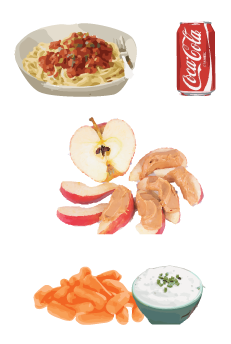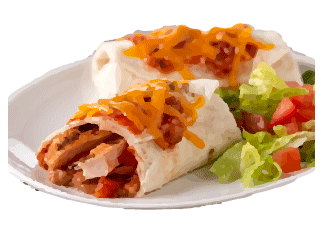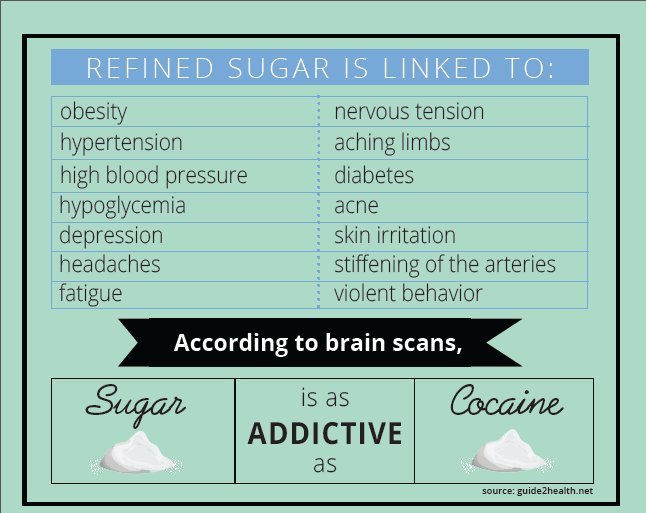(Not so) sweet
Studies have shown that sugar is a leading cause of obesity. Many people unknowingly consume large amounts of sugar every day in heavily processed foods.
January 20, 2015
by Gloria Cowdin, graphics by Maria Donnelly
 7:15– you quickly eat a bowl of cereal while waiting for your carpool.
7:15– you quickly eat a bowl of cereal while waiting for your carpool.
cereal: Lucky Charms GRAMS OF SUGAR: 10
7:25– your carpool decides to visit the Starbucks drive-through for a morning pick-me-up.
drink: 16 oz. Pumpkin Spice Latte GRAMS OF SUGAR: 49
9:30– during a free, you and a friend visit the development office for some treats.
treat: two mini snickers (combined) GRAMS OF SUGAR: 36
 10:50– advisory time=snack time. someone brought in cheezits to share.
10:50– advisory time=snack time. someone brought in cheezits to share.
snack: 27 cheez-its GRAMS OF SUGAR: 1
1 1:30– lunch time! Your mom packed you something healthy today.
1:30– lunch time! Your mom packed you something healthy today.
lunch: 20 oz. Coca-Cola (the rest of your lunch is healthy, so it’s ok), pasta with red sauce, carrot sticks with ranch, and an apple with peanut butter.
(combined) GRAMS OF SUGAR: 65+1+12+6+2+13+3 = 102
3:30– finally home from school. you had a healthy lunch today, so you deserve a little indulgence.
snack: six oreos GRAMS OF SUGAR: 28
 6:30– your dad picked up chipotle on his way home from work tonight
6:30– your dad picked up chipotle on his way home from work tonight
dinner: chicken burrito with the works GRAMS OF SUGAR: 8
8:00– a little dessert before you finally start your homework, right?
dessert: one scoop of chocolate chip ice cream GRAMS OF SUGAR: 16
250 grams. The average amount of sugar consumed in an STA girl’s day.
Four grams equals 1 teaspoon, which means there are about 62 teaspoons in 250 grams. This is equivalent to consuming 1 and ¼ cups of sugar a day. Maybe that doesn’t seem like a huge deal to you. A cup of sugar isn’t that much, right? Wrong. According to the American Heart Association, women should only consume about 6 teaspoons, or 30 grams, of sugar a day. Going by this recommendation, we consume roughly 8 times more sugar than we should every day.
Now think about all your “bad food” days. Or the days you stop by the development office for candy more than once. Or when you choose to drink sugary beverages with every meal. Countless foods and drinks like these pile up and contribute to causing an epidemic that is steadily taking over America: obesity.
According to Kick the Can, a website that is part of a project of the California Center for Public Health Advocacy (CCPHA), more than ⅓ of American adults are obese. Additionally, while soda consumption has doubled in the last 30 years, diabetes diagnoses have tripled. Lowering these statistics can begin with children and teens learning to be more conscious about their eating decisions.
According to principal of student affairs Mary Beth Compton, STA provides a multitude of support systems to enhance overall student wellbeing, but some gaps still remain in the area of healthy eating.
“A big initiative of our school, and me personally–something I believe in strongly– is just overall wellness” Compton said. “Physical, emotional, mental wellness. I so agree with this premise that your diet makes up a huge part of that.”
However, many STA organizations hand out sweets on a regular basis. The development offices and many administrative offices offer mini candy bars to students who drop in, and the Fine Arts Boosters sell $1 donuts in the front halls of the M&A Building and Donnelly Hall every Thursday. The problem with these treats is that they become a regular part of many students’ diets. Junior Emma Fernandez, who avoids most processed foods and tries to include every food group in her meals, believes eliminating these sugary foods would benefit students.
“We’re already learning here, so we don’t want to have bad eating habits while we’re learning” Fernandez said. “Like the donuts, for instance, that’s breakfast, and you don’t want to eat a bunch of sugar right before you have a day of taking tests. That’s not a good way to start out your day. With right nutrition, I think it would be easier.”
According to Compton, administrative offices hand out candy to promote student interaction where there would otherwise be none. However, she agreed that STA can improve the quality of its snacks, or at least provide healthy alternatives to the candy and donuts. In the last few years, the school has taken steps to encourage healthier eating, such as introducing a local lunch program.
“I think [healthy eating is] something that needs to be ongoing and continually revisited. I don’t think it’s ever a box that we check.” Compton said. “Bistro [Kids] is a big step. It was a big investment and commitment by the school to say ‘let’s bring in fresh, organic food, healthy choices; whether it’s a salad bar or entree.’”
Bistro Kids is a Kansas City based school lunch program that offers local, sustainable, made-from-scratch meals for students. STA is one of ten schools in the Kansas City area that uses Bistro’s lunch program. According to head chef, Scott Brake, Bistro lunches avoid using processed sugars as much as possible and always provide alternative options for a sometimes much needed sugar-fix, such as fruit. Additionally, Bistro always provides a salad bar at lunch and has small gardens starting up outside M&A. The idea behind Bistro is that mental wellness directly relates to physical wellness, something which healthy eating enhances.
“This is why I do this job, because I believe in healthy eating” Brake said. “Being healthy and nutritious and feeding people in a healthy manner is something that I feel pretty strongly about and that’s the reason why I’m in.”
Although STA continues making efforts to provide girls with healthier eating options, the decision of whether or not to eat better ultimately rests on students. Are you thinking about having a big glass of juice after school today? Eat fresh fruit instead, which contains nutritious fibers to keep you full. Tempted to stop by every office that offers candy? Swap the candy for a granola bar and you’ll be more energized for longer.
Teaspoon by teaspoon, students can begin to eliminate processed sugars from their diets and lower the statistics that are weighing down our country.






Maura O'Connor • Feb 5, 2015 at 4:02 am
Great article! As an aluma (class of 1977) and former Dart staffer and copy editor, it’s terrific to see STA women putting out such well-written articles on important topics. There is not enough written about the many adverse impacts of sugar on our health. Very impressive.